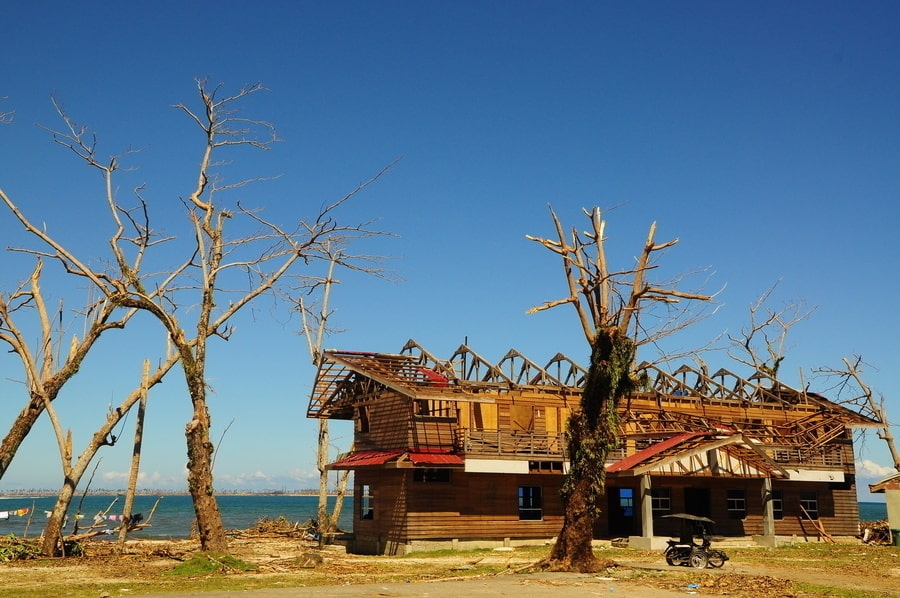A Call to Action: a Comprehensive Approach to Human Mobility in the Context of the Climate Crisis
This article by António Vitorino was originally published in the Forced Migration Review (FMR) Issue 69, in March 2022.
We are approaching key global milestones in the challenge we face to address the human mobility implications of the climate crisis – with deadlines that we are struggling to meet. We need to act urgently, collectively, inclusively and ambitiously.
As our planet’s temperatures rise, ecosystems are collapsing, species are disappearing, and we are witnessing a growing number of devastating disasters. No society, no community will be unaffected: livelihoods are being depleted, food and water security are being undermined, while inequality, poverty and deprivation are being magnified. We are heading towards a world in which the achievement of the Sustainable Development Goals will become increasingly distant, difficult and costly – and we are yet to change course.
The environmental crisis has profound implications for human mobility. Growing numbers of people will be displaced, many forced to abandon their homes for ever; others will have little choice but to remain in places that will become ever more dangerous and fragile; well-established migration routes and systems will be disrupted. It is imperative that migration, displacement and immobility become an integral part of climate action.
This will be a complex undertaking, requiring comprehensive solutions that preserve and promote the well-being, security and resilience of people on the move and their communities. It will also require all of us to work together. The international community committed in the Global Compact for Safe, Orderly and Regular Migration (GCM) to address adverse drivers compelling people to leave their homes, while also making available pathways for regular migration, and promoting social cohesion and access to services for migrants. It is time to act to put these commitments front and centre in our efforts to promote sustainable development and address climate change.
Ensuring that people can move in a safe and dignified manner
People will continue to move, as they always have – to survive, cope with hardship, and thrive. Throughout human history, population movements have underpinned the prosperity of nations and communities; today, it is impossible to imagine successful adaptation to climate change without migration and mobility, the transfer and investment of remittances, and the circulation of skills and ideas. Ensuring that those who face the worst impacts of the climate crisis will be able to move in a safe and dignified manner will be key to preserving their adaptive capacity.
Doomsday scenarios suggesting large-scale movements of people to high-income countries do not reflect today’s reality, nor future outlooks. Population movements linked with environmental factors are, and will remain, primarily short-distance and internal. The impacts of environmental change will, however, translate into more difficult migration decisions, riskier journeys, and more precarious situations for those on the move.
IOM is working with its Member States and multilateral institutions to help ensure that migration governance systems can effectively address these emerging situations. Frameworks and protocols that enable cross-border movements (developed primarily to manage labour migration) are key to facilitating migration in the context of climate change and supporting adaptation and resilience. Regional economic communities throughout Africa, Europe and Latin America are excellent examples of these flexible arrangements. Frameworks to facilitate the free movement of people, such as those in the ECOWAS and IGAD regions, help preserve the resilience of mobile people who will be particularly affected by climate change due to their dependency on natural resources. People moving across borders due to disasters and climate change may be granted access to existing immigration categories, while visa policies and ethical labour migration schemes can be used to support adaptation, disaster risk reduction (DRR) and post-disaster recovery.
Because migration is primarily internal rather than across borders, we need to remain alert to its local implications. Climate migration will be first and foremost a matter of – largely urban – planning and service provision, and we must support local authorities in integrating climate and migration dimensions in their work. It is through local-level work, particularly in cities, that we will build migrant-inclusive societies, and thereby promote collective well-being and resilience. In Senegal and Côte d’Ivoire, for instance, IOM involves migrants in the design and implementation of nature-based solutions to flood risk and food insecurity in urban and peri-urban areas. These initiatives promote recognition of the skills and protection of the rights of migrant workers in the agricultural sector, while building the resilience of their communities.
It can be a challenge to scale up and disseminate the experience gained from localised approaches but there are already effective ways to exchange information, learn common lessons and mobilise partners and resources. The UN Network on Migration, the Mayors Migration Council, the Task Force on Displacement, the Platform on Disaster Displacement, and the Regional Consultative Processes on Migration are examples of relevant networks and forums.
Reducing disaster and climate risk
The Sendai Framework for Disaster Risk Reduction and the Paris Agreement set out clear blueprints to reduce existing and future climate-related risks. Risk reduction and adaptation are central to all development, humanitarian and peace concerns – including as they relate to the governance of migration and the management of displacement. Key frameworks on human mobility, such as the GCM or regional and national migration and displacement policies, have recognised the need to reduce the impacts of hazards. There is today a pressing need for coordinated and all-of society approaches that bring together disaster risk management, climate change adaptation and human mobility actors, plus affected communities themselves.
Excellent examples of such work already exist. The Asia-Pacific Working Group on Disaster Displacement has regularly brought together displacement and disaster management institutions to share lessons and mobilise action. Including human mobility practitioners in national coordination bodies, such as the National Platform in Burundi, has facilitated the integration of mobility concerns in DRR planning. Countries such as Vanuatu and Mozambique are now institutionalising this approach by integrating disaster and human mobility[1]related policies and approaches. IOM, together with its partners in the Capacity for Disaster Reduction Initiative (CADRI), also supports these processes by providing governments with capacity assessments on DRR that specifically account for migration, displacement and planned relocation issues, and that can help prioritise follow-up action.
Assisting and protecting people on the move
The crises of recent years have shown us that we need to prepare for a world with heightened humanitarian needs, as communities around the world experience more frequent, more intense, overlapping disasters, that progressively erode people’s resilience and leave a limited space for recovery. We know that anticipating and responding to losses and damages in a changing climate will also mean preparing for, and addressing, forced migration and displacement. Internal and cross[1]border movement – while key to coping and, in some cases, surviving – may place people in life-threatening, undignified situations, undermine their resources and resilience, and increase their likelihood of suffering violence and insecurity and being affected by future hazards.
Preparing for, addressing and resolving displacement will be key to reducing one of the key impacts of hazards and climate change. It will also be essential to avoiding the indirect losses and damages that disasters and climate change produce through displacement and migration: impoverishment, community disruption, tensions and instability, and environmental degradation. To this end, all disaster preparedness, response and recovery activities need to integrate displacement and migration management, protection and durable solutions considerations.
There also needs to be a collective shift towards anticipatory approaches, through use of risk assessments, hazard monitoring and early warning systems that inform preparedness and early action. In its role as Agency Lead (in the Cluster Approach) for assisting people displaced internally following disasters triggered by natural hazards, IOM has been supporting efforts relating to anticipating and monitoring disaster displacement in the Pacific, strengthening warning systems and infrastructure in Nepal and the Philippines, and building capacity (and promoting inclusion of displaced persons) in risk reduction in South Sudan, Bangladesh and Haiti and in West, Southern and Central Africa.
We must continue to build bridges between two sets of actors that have too often worked in isolation: those dealing with disaster risk reduction and emergency preparedness, and those dealing with migration and displacement management. And we need to propose new collective approaches that complement traditional humanitarian and durable solutions interventions with greater foresight, coordination and capacity building.
A collective call for action
We are approaching key global milestones, and deadlines that we have yet to meet. We have set clear development objectives, climate change mitigation and disaster risk reduction targets, and ambitious humanitarian commitments. We have defined roles, responsibilities and timelines for implementation. Now we must act, and act urgently. The cost of climate and environmental inaction looms large over our collective well-being.
As stressed most recently at COP26 in Glasgow, we need investments to decarbonise our economies to avoid further greenhouse gas emissions, and to reduce our footprint on ecosystems and biodiversity. We need predictable, adequate and sustainable funding and assistance to reduce disaster risk and adapt to the negative impacts of climate change. We need clear commitments to address losses and damages brought about by anthropogenic environmental change, in order to support the most vulnerable communities and the people worst affected. And we need to ensure that all these efforts contribute to the creation of more inclusive and just societies.
Ensuring that migration and displacement are fully considered within this range of complex issues and actions may be challenging, but is essential to achieving any progress. The upcoming International Migration Review Forum (IMRF) in May 2022 provides States with an opportunity to put migration at the centre of our reflections and actions. The IMRF will enable us to mobilise a diversity of actors on all facets of this conversation, and to listen to the voices of migrants and displaced persons, who are so neglected in global policy conversations. It will allow us to reflect on the progress we have achieved against the objectives of the GCM, and to highlight how these efforts support our work to achieve the development and humanitarian goals of the many other frameworks we have committed to. It will prompt us to renew our commitments, and pledge further action on these issues. In order to guide its own efforts, for example, IOM has developed a 10-year strategy to address the migration, environment and climate change nexus, focusing on solutions for people to stay, to move, and to be protected and assisted while on the move.
As we wade more deeply into this crucial decade for our common future, we need to remain alert to the complexity of these issues and promote appropriate responses. We need to ensure migration is safe and dignified; where migrants have adequate access to services and opportunities, they can mobilise resources to support development and resilience across communities and societies. We need to anticipate the mobility outcomes of disasters and environmental degradation; it is essential to build preparedness and recognise in advance the implications of migration and displacement in the context of a changing climate, so that we can reduce negative environmental impacts and protect development. Perhaps, more than anything, we need a new common narrative: one that is not paralysed by fear of people on the move but that fully recognises the rights, capacities and contributions of those most affected by climate change and seeks effective solutions that offer a choice as to whether to stay or move.
Cover photo: © IOM | Billy Jamisolamin





